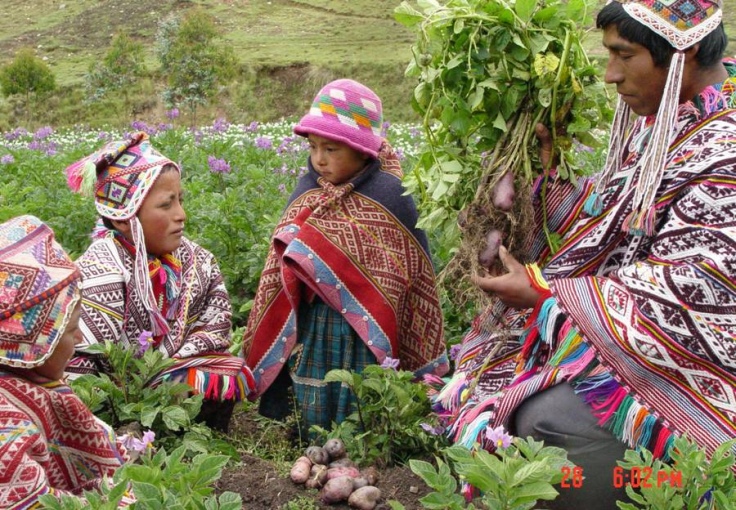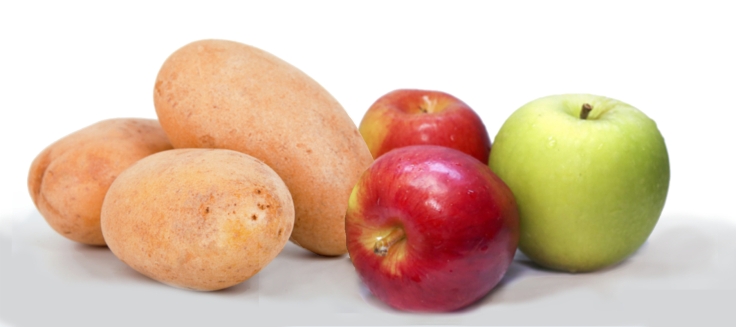Here in Europe, potatoes have been our staple food since they were introduced in the 16th century. Since then we have come up with many inventive ways of cooking potatoes, from baked potatoes to French fries. In the words of Samwise Gamgee (lord of the rings) “Boil ‘em, mash ‘em, stick ‘em in a stew”[1].
Potatoes provide essential carbohydrates for energy, while containing almost no fat. They also give you 21% of recommended daily potassium intake, all vital nutrients (except vitamin A and D), fibre and minerals such as iron, zinc and magnesium. Compared to corn, potatoes have more protein and nearly double the amount of calcium[2].
Despite our love of potatoes, they are one of the most wasted foods on the planet! In Sweden alone, 85,000 tonnes of potatoes were wasted in 2009[3]!
History
In the past, potatoes originated in the Andes Mountains almost seven thousand years ago. Potatoes can survive in even the harshest of soil conditions, at altitudes as high as 15,000 feet. Potatoes were cultivated before people understood some of the basics of farming. The South American population used to eat all the best and biggest potatoes and plant the rest, meaning that potatoes grown each year got smaller and smaller. The Spanish then introduced potatoes after visiting South America in 1532. The farming of potatoes then spread throughout Europe and India, even reaching far off areas in china.

Storage
Potatoes are still alive when they are picked, so they are very sensitive to the way they are stored. To prolong the life of your potatoes, they should be stored in a cool, dark and dry place.
Ideally potatoes should be stored at a temperature of 7-10°C. If kept at a warmer temperature, they will shrivel and shrink as they are composed of 80% water. If they are kept in the fridge the potato starch will convert to sugar. This will make them taste sweeter and may cause them to darken very quickly if fried. But don’t worry if you store your potatoes in a too cold environment, as this process can be reversed if the potatoes are left out of the fridge for 7-10 days. Raw potatoes shouldn’t be frozen, however part-cooked chips are the best form a potato can be frozen in. Despite this, as potatoes are formed of mostly water, ice crystals can develop and surround the chips.
When exposed to direct sunlight, they can develop green spots. If this occurs, the potato can still be used, yet you may wish to cut off the green spots.
If they are kept in a humid climate they may begin to grow mould. If you see mould on your potato, unfortunately it cannot be used and should be disposed of. Humidity can also cause the potato to grow new white sprouts. Although the potato can still be used once the sprouts have been cut off, the quality of the potato may have reduced. If you don’t fancy eating a sprouted potato, why not plant it to start growing your very own home-grown potatoes? In any case, to avoid the possibility of mould and sprouting, do not wash before storage. Plastic bags can increase humidity of the air inside, so removing potatoes from plastic bags or storing in paper bags will help to increase their shelf life.
As potatoes remain alive until cooked, they can respond to other fruits and vegetables in close proximity. It is useful to be aware that potatoes and onions shouldn’t be stored close together as gases from the onions can encourage potatoes to begin sprouting quicker. For ideal results, keep potatoes close to apples, as ethylene gases produced by apples can prevent potatoes from sprouting. Since apples often cause other fruits and vegetables to ripen too soon, storing these away from them with potatoes can also increase the shelf life of your other foods.

Once cut, the whole potato should be used as the inside of potatoes oxidise quickly once exposed to the air. This can be temporarily resolved by putting them immediately into a pan of salted water once cut. Once potatoes are prepared, they should be kept in a tightly closed container to keep out moisture and any contaminants.
Recipe ideas
Potatoes are one of the highest types of food to be wasted after being prepared for a meal[4]. You can reduce your potato waste by following some of these leftovers recipes.
Why not turn last night’s mash potato into breakfast potato pancakes?
Check out the Potato pancake recipe
You can use leftover mash, boiled or roast potatoes to make the delicious traditionally British dish of Bubble and Squeak
Don’t waste your potato skins! Potatoes contain 45% of your Recommended Daily Intake (RDI) of vitamin C is contained in a medium (150g) potato, with almost all of this healthy goodness found within the first few millimetres under the skin[2].
When making mashed potatoes, keep the skins on to make a more nutritious, fuller tasting mash.
Why not try roasting your potato peels to taste like a chip with more flavour? These can be the perfect light snack before dinner.
Check out the Roasted potato peel recipe
If your potatoes go a bit too soft and squishy, don’t waste them! These are great to put in a soup as the rubbery texture is hidden and it makes them easier to blend.
Replant them! Potatoes are unlike other major food crops in that they reproduce vegetatively from other potatoes. This means that potato seeds are in fact potatoes themselves. So if you have a potato that you don’t think you will eat, plant it in some moist soil and wait for a new batch of your very own home-grown potatoes.
References
- Jackson, P. (Director & Producer) (2002) The Lord of the Rings: The Two Towers [Film]. WingNut Films The Saul Zaentz Company.
- Linda Murray (2003) Potato. Encyclopedia of Food and Culture. Retrieved from: http://www.encyclopedia.com/topic/potato.aspx
- Leal Filho, W., & Kovaleva, M. (2015). Food Waste and Sustainable Food Waste Management in the Baltic Sea Region. Springer.
- Sonesson, U., Anteson, F., Davis, J., & Sjödén, P. O. (2005). Home transport and wastage: environmentally relevant household activities in the life cycle of food. AMBIO: A Journal of the Human Environment, 34(4), 371-375.
- EatByDate (n.d.) How long do potatoes last? Retrieved from: http://www.eatbydate.com/vegetables/fresh-vegetables/potatoes-shelf-life-expiration-date/
- FAO (2008) International year of the potato. Retrieved from: http://www.fao.org/potato-2008/en/potato/utilization.html
- Horton, D. E. (1987). Potatoes: Production, marketing, and programs for developing countries. International Potato Center.
- R.E. (2015, December 23) A Potato Glossary. Tucker Farms, Inc. Retrieved from: http://www.tuckertaters.com/potato-glossary.pdf

April 5, 2016 at 3:09 pm
Thanks for the interesting summary about potatoes and the hint to store them with apples 🙂
I will try it out!
LikeLike
April 25, 2016 at 9:36 am
I’m really glad you liked it!
LikeLike
July 27, 2016 at 8:14 am
Gosh, you just saved my onions !
LikeLike